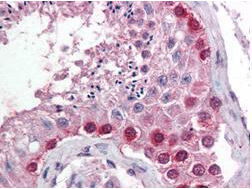Anti-Cul4A (N-terminal specific) (RABBIT) Antibody
Cul4A Antibody
- SPECIFICATION
- CITATIONS
- PROTOCOLS
- BACKGROUND

| Host | Rabbit |
|---|---|
| Conjugate | Unconjugated |
| Target Species | Human |
| Reactivity | Human |
| Clonality | Polyclonal |
Application
| WB, IHC, E, IP, I, LCI |
| Application Note | Anti-Cul4A has been tested by western blot, immunoprecipitation, and immunohistochemistry. The antibody immunoprecipitates protein from cell lysates (using HeLa, U2OS and others). This antibody also co-immunoprecipitates at least 8 subunits of COP9, DDB1 and CAND1. An 87.6 kDa band corresponding to human Cul4A is detected. Most cell lines expressing Cul4A can be used as a positive control. Researchers should determine optimal titers for other applications. |
| Physical State | Liquid (sterile filtered) |
| Immunogen | This antibody was prepared from whole rabbit serum produced by repeated immunizations with a synthetic peptide corresponding to the N-Terminal region near amino acids 1-25 of Human Cul4A coupled to KLH. |
| Preservative | 0.01% (w/v) Sodium Azide |
| Gene ID | 8451 |
|---|---|
| Other Names | 8451 |
| Purity | This product is monospecific antiserum processed by delipidation and defibrination followed by sterile filtration. This product reacts with human Cullin 4A. Cross reactivity is expected against mouse Cul4A based on a high degree of sequence homology. Cross reactivity with other human cullins may occur. |
| Storage Condition | Store vial at -20° C prior to opening. Aliquot contents and freeze at -20° C or below for extended storage. Avoid cycles of freezing and thawing. Centrifuge product if not completely clear after standing at room temperature. This product is stable for several weeks at 4° C as an undiluted liquid. Dilute only prior to immediate use. |
| Precautions Note | This product is for research use only and is not intended for therapeutic or diagnostic applications. |
| Name | CUL4A {ECO:0000303|PubMed:9721878, ECO:0000312|HGNC:HGNC:2554} |
|---|---|
| Function | Core component of multiple cullin-RING-based E3 ubiquitin- protein ligase complexes which mediate the ubiquitination of target proteins (PubMed:14578910, PubMed:14739464, PubMed:15448697, PubMed:15548678, PubMed:15811626, PubMed:16678110, PubMed:17041588, PubMed:24209620, PubMed:30166453, PubMed:33854232, PubMed:33854239). As a scaffold protein may contribute to catalysis through positioning of the substrate and the ubiquitin-conjugating enzyme (PubMed:14578910, PubMed:14739464, PubMed:15448697, PubMed:15548678, PubMed:15811626, PubMed:16678110, PubMed:17041588, PubMed:24209620). The E3 ubiquitin- protein ligase activity of the complex is dependent on the neddylation of the cullin subunit and is inhibited by the association of the deneddylated cullin subunit with TIP120A/CAND1 (PubMed:14578910, PubMed:14739464, PubMed:15448697, PubMed:15548678, PubMed:15811626, PubMed:16678110, PubMed:17041588, PubMed:24209620). The functional specificity of the E3 ubiquitin-protein ligase complex depends on the variable substrate recognition component (PubMed:14578910, PubMed:14739464, PubMed:15448697, PubMed:15548678, PubMed:15811626, PubMed:16678110, PubMed:17041588, PubMed:24209620). DCX(DET1-COP1) directs ubiquitination of JUN (PubMed:14739464). DCX(DDB2) directs ubiquitination of XPC (PubMed:15811626). DCX(DDB2) ubiquitinates histones H3-H4 and is required for efficient histone deposition during replication-coupled (H3.1) and replication-independent (H3.3) nucleosome assembly, probably by facilitating the transfer of H3 from ASF1A/ASF1B to other chaperones involved in histone deposition (PubMed:16678110, PubMed:17041588, PubMed:24209620). DCX(DTL) plays a role in PCNA-dependent polyubiquitination of CDT1 and MDM2-dependent ubiquitination of p53/TP53 in response to radiation-induced DNA damage and during DNA replication (PubMed:14578910, PubMed:15448697, PubMed:15548678). DCX(DTL) directs autoubiquitination of DTL (PubMed:23478445). In association with DDB1 and SKP2 probably is involved in ubiquitination of CDKN1B/p27kip (PubMed:16537899). Is involved in ubiquitination of HOXA9 (PubMed:14609952). The DDB1-CUL4A- DTL E3 ligase complex regulates the circadian clock function by mediating the ubiquitination and degradation of CRY1 (PubMed:26431207). The DCX(ERCC8) complex (also named CSA complex) plays a role in transcription-coupled repair (TCR) (PubMed:12732143, PubMed:32355176, PubMed:38316879). A number of DCX complexes (containing either TRPC4AP or DCAF12 as substrate-recognition component) are part of the DesCEND (destruction via C-end degrons) pathway, which recognizes a C-degron located at the extreme C terminus of target proteins, leading to their ubiquitination and degradation (PubMed:29779948). The DCX(AMBRA1) complex is a master regulator of the transition from G1 to S cell phase by mediating ubiquitination of phosphorylated cyclin-D (CCND1, CCND2 and CCND3) (PubMed:33854232, PubMed:33854239). The DCX(AMBRA1) complex also acts as a regulator of Cul5-RING (CRL5) E3 ubiquitin-protein ligase complexes by mediating ubiquitination and degradation of Elongin-C (ELOC) component of CRL5 complexes (PubMed:30166453). With CUL4B, contributes to ribosome biogenesis (PubMed:26711351). |

Thousands of laboratories across the world have published research that depended on the performance of antibodies from Abcepta to advance their research. Check out links to articles that cite our products in major peer-reviewed journals, organized by research category.
info@abcepta.com, and receive a free "I Love Antibodies" mug.
Provided below are standard protocols that you may find useful for product applications.
Background
Cullins assemble a potentially large number of ubiquitin ligases by binding to the RING protein ROC1 to catalyse polyubiquitination, as well as binding to various specificity factors to recruit substrates. Cullin 4a is an essential component of the SCF (SKP1-CUL1-F-box protein) E3 ubiquitin ligase complex, which mediates the ubiquitination of proteins involved in cell cycle progression, signal transduction and transcription. In the SCF complex, cul4A serves as a rigid scaffold that organizes the SKP1-F-box protein and RBX1 subunits. Cul4A may also contribute to catalysis through positioning of the substrate and the ubiquitin-conjugating enzyme. Cul4A also interacts with RNF7 and is part of a complex with TIP120A/CAND1, Cyclin E and RBX1.
If you have used an Abcepta product and would like to share how it has performed, please click on the "Submit Review" button and provide the requested information. Our staff will examine and post your review and contact you if needed.
If you have any additional inquiries please email technical services at tech@abcepta.com.













 Foundational characteristics of cancer include proliferation, angiogenesis, migration, evasion of apoptosis, and cellular immortality. Find key markers for these cellular processes and antibodies to detect them.
Foundational characteristics of cancer include proliferation, angiogenesis, migration, evasion of apoptosis, and cellular immortality. Find key markers for these cellular processes and antibodies to detect them. The SUMOplot™ Analysis Program predicts and scores sumoylation sites in your protein. SUMOylation is a post-translational modification involved in various cellular processes, such as nuclear-cytosolic transport, transcriptional regulation, apoptosis, protein stability, response to stress, and progression through the cell cycle.
The SUMOplot™ Analysis Program predicts and scores sumoylation sites in your protein. SUMOylation is a post-translational modification involved in various cellular processes, such as nuclear-cytosolic transport, transcriptional regulation, apoptosis, protein stability, response to stress, and progression through the cell cycle. The Autophagy Receptor Motif Plotter predicts and scores autophagy receptor binding sites in your protein. Identifying proteins connected to this pathway is critical to understanding the role of autophagy in physiological as well as pathological processes such as development, differentiation, neurodegenerative diseases, stress, infection, and cancer.
The Autophagy Receptor Motif Plotter predicts and scores autophagy receptor binding sites in your protein. Identifying proteins connected to this pathway is critical to understanding the role of autophagy in physiological as well as pathological processes such as development, differentiation, neurodegenerative diseases, stress, infection, and cancer.


